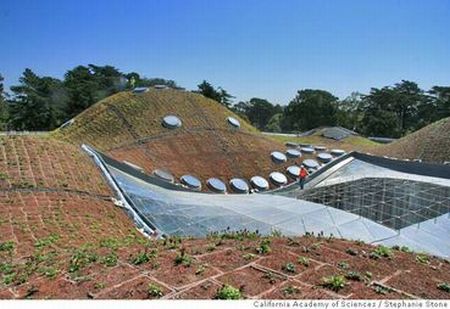
Turf roofs are good sound and temperature insulators. In hot weather, the turf layer keeps the rooms cool. Turf roof is a main attraction at San Francisco’s new Academy of Sciences, arguably the greenest museum in the world. The museum consists of its spherical planetarium, domed rain forest, high-tech piazza with suspended glass roof and Plexiglas tunnels – is innovative enough to banish the stuffy taint associated with natural history. These hills of 1.7 million plants growing in 50,000 biodegradable coconut husk trays comprise the most inspiring element of the whole museum.
Since the plants were chosen to attract local butterflies, birds and insects, some of which are endangered, the roof offers a quietly utopian statement. The reason behind making roof like these in an era of carbon consciousness, it’s only natural that green roofs should gain currency for a wide variety of reasons. By providing insulation, they lower energy bills. By absorbing rainwater, they reduce storm runoff – one of the primary ways nitrate and phosphorous pollution get into our groundwater.
Some research has shown that in hot cities like Riyadh, Saudi Arabia, green roofs could reduce inner-city temperatures by 10 degrees. One deterrent is price – although turf roofs are supposed to last twice as long as traditional roofs, they are more expensive – an estimated 300 percent more. But, factoring in the building’s lower energy costs and reduced storm runoff infrastructure lowers the price substantially. And as turf roofs grow more popular, the price has dropped substantially.




